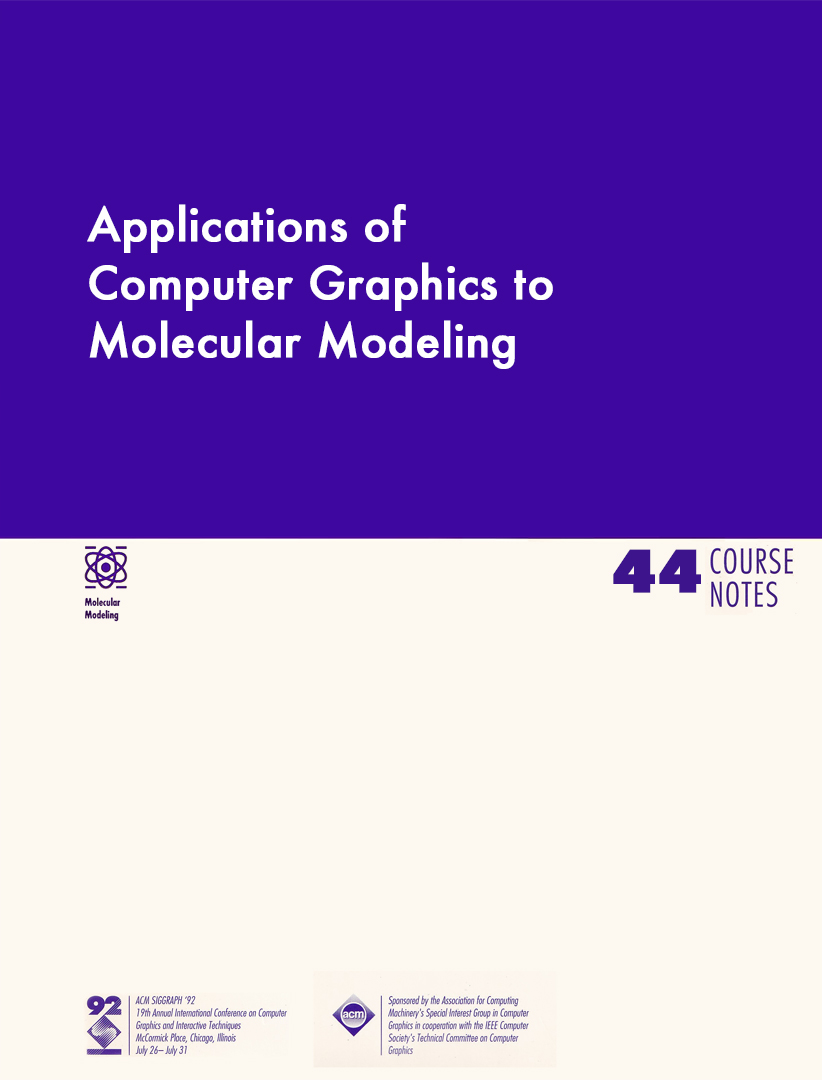“Applications of Computer Graphics to Molecular Modeling” by O’Donnell, Hutchins, Kellogg, Olejniczak and Olson
Conference:
Type(s):
Title:
- Applications of Computer Graphics to Molecular Modeling
Organizer(s):
Presenter(s)/Author(s):
- TJ O’Donnell
- Charles W. Hutchins
- Glen Eugene Kellogg
- Edward (Ed) Thaddeus Olejniczak
- Arthur J. Olson
Entry Number: 44
Abstract:
Intermediate
Working knowledge of 3D chemical structures (first-year undergraduate chemistry) and at least one software system used for molecular structure display either on a workstation or PC. Some background in proteins is helpful.
Who Should Attend
People who actively are involved in scientific visualization, especially chemistry, or who support those researchers through design of computer graphics applications.
Objectives
The course covers the application of molecular modeling in its widest sense, by demonstrating new ways for research chemists to look at familiar modeling data. Examples focus on how computer graphics is being used to develop and refine models of molecular structure. The course provides practical applications of computer graphics technologies in molecular modeling and explores opportunities to improve technology to satisfy chemists.
Description
Computer graphics has been used in chemistry since the beginning of computer graphics. Some of the very first computer graphics systems were used by chemists to display simple line drawings of their three dimensional molecular structures and dot surfaces surrounding them. The ability to visualize large and complex molecular structures as well as the ability to compute properties of molecules and their interactions has given rise to a new field of chemistry known as computer assisted molecular design (CAMD). While CAMD is sometimes compared to CAD/CAM, its purpose is not to design a shape before it is made into reality, but rather to understand the nature of the intricate interactions between molecules which is responsible for much of the usefulness of chemistry in our society. For example, the ability of a drug molecule to act upon its receptor in the body is directly and indirectly due to the three dimensional complementarity in shape of the drug and its receptor. Many molecular properties, such as electronic properties are indirectly dependent upon the 3-D shape of the molecule. Computer graphics and computational chemistry has become so useful that several commercial modeling systems are currently available and are being used in chemical and pharmaceutical companies throughout the world as well as in university and other research organizations.
In this course we will show how computer graphics is being used today in protein modeling, nuclear magnetic resonance (NMR) and in the display of black and white molecular illustrations. In protein modeling, the protein itself is a complex three dimensional association of atoms. We will explain ways in which proteins are graphically displayed and manipulated. We will also show how techniques or molecular modeling are used to construct models of drug receptor interactions. Electronic properties of proteins are studied to understand how they interact with each other and with smaller molecules. The electronic properties can be computed and displayed either on a molecular surface or in the space around the molecule. Techniques for displaying three dimensional contours of electronic properties are used for this. In NMR, multidimensional data is collected in order to deduce the three dimensional structure of a molecule. In the last several years, this approach has been used to determine the solutions structure of molecules as large as proteins. Graphical methods for interpreting the multidimensional data will be presented.
An important issue in computer graphics is how to present our work in more traditional media such as books, films and video, so that an audience without a graphics workstation can see the results of our efforts. We will discuss how best to select what you want to show, how to plan and produce animations. Future directions incorporating video with computer graphics as supplements to paper publications. We will also discuss a relatively new stereo viewing medium, the phscologram, and show results for two molecular systems.
Contents/Schedule PDF:
Contributed By:
- Mary Whitton
Location:
- Charles Babbage Institute Archives, University of Minnesota





